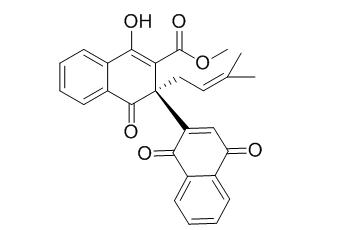Rubipodanone A
Reference standards.
Inquire / Order:
manager@chemfaces.com
Technical Inquiries:
service@chemfaces.com
Tel:
+86-27-84237783
Fax:
+86-27-84254680
Address:
1 Building, No. 83, CheCheng Rd., Wuhan Economic and Technological Development Zone, Wuhan, Hubei 430056, PRC
Providing storage is as stated on the product vial and the vial is kept tightly sealed, the product can be stored for up to
24 months(2-8C).
Wherever possible, you should prepare and use solutions on the same day. However, if you need to make up stock solutions in advance, we recommend that you store the solution as aliquots in tightly sealed vials at -20C. Generally, these will be useable for up to two weeks. Before use, and prior to opening the vial we recommend that you allow your product to equilibrate to room temperature for at least 1 hour.
Need more advice on solubility, usage and handling? Please email to: service@chemfaces.com
The packaging of the product may have turned upside down during transportation, resulting in the natural compounds adhering to the neck or cap of the vial. take the vial out of its packaging and gently shake to let the compounds fall to the bottom of the vial. for liquid products, centrifuge at 200-500 RPM to gather the liquid at the bottom of the vial. try to avoid loss or contamination during handling.
Curr Top Med Chem.2020, 20(21):1898-1909.
J Nat Med.2021, doi: 10.1007.
Biomed Pharmacother.2024, 171:116166.
Plant Direct.2021, 5(12):e372.
Biomed Pharmacother.2024, 175:116770.
Molecules.2023, 28(4):1785.
J Med Food.2020, 23(6):633-640.
J Ethnopharmacol.2022, 282:114574.
Int J Mol Sci.2024, 25(18):9909.
PLoS One.2018, 13(11):e0208055
Related and Featured Products
Phytochemistry. 2018 Jan;145:153-160.
Rubipodanones A-D, naphthohydroquinone dimers from the roots and rhizomes of Rubia podantha.[Pubmed:
29132078]
Four previously undescribed naphthohydroquinone dimers named Rubipodanone A, rubipodanone B, rubipodanone C, rubipodanone D, together with 19 known quinones containing three known napthohydroquinone dimers named rubioncolin C, methyl 5-hydroxy-dinaphtho[1,2-2',3']furan-7,12-dione-6-carboxylate and rubialatin B, were isolated from the roots and rhizomes of Rubia podantha.
METHODS AND RESULTS:
Their structures and absolute configurations were determined mainly by NMR, X-ray diffraction, and computational methods. Rubipodanones C and D, the glycosides of Rubipodanone A and a pair of C-3 epimer, are the first identified dimeric napthohydroquinone glycosides from the Rubia plants. All naphthohydroquinone dimers were evaluated for their cytotoxicities against ten tumor cell lines and effects on the tumor-associated NF-κB signaling pathway, and rubioncolin C showed the best cytotoxicity with IC50 value of 1.53 μM and NF-κB inhibitory activity with IC50 value of 2.97 μM.
CONCLUSIONS:
These results also demonstrated that the key roles of C-3 configuration and sugar group for biological activities of rubipodanone C.



